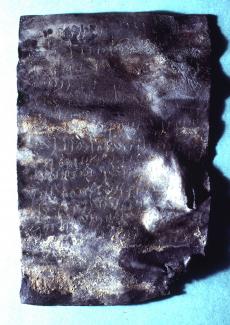Sitefind, metal detector find, Roman lead defixio (lead curse tablet) dedicated to Neptune, found River Hamble, Hampshire
‘Curse tablets’ of the Greco-Roman world are associated mostly with civil and criminal court cases but also with unsolved crimes and personal grievances. In the Roman Empire they were usually inscribed with a stylus on lead tablets (tabletae defixio), although wooden tablets, papyri and other materials were also used. In both Classical Greece and Roman Britain the use of lead was probably due to its plentiful natural occurrence.
The heavy, cold and dull nature of lead also made it appear a natural medium for inscribed curses because such attributes, commonly associated with lifelessness, were thought to be transferable to the targeted individuals. Lead curse tablets in Britain are found in rectangular form while in other parts of the Empire the inscribed material may take a human or even animal shape. Generally, tablets do not measure more than about 80mm x 120mm with texts written on one side only.
The tablet from Badnam Creek, a tributary of the Hamble River, was found by metal detector in 1982. The curse, dating from about 350 to 400 AD, was directed by a man named Muconius at the unknown thief who had stolen his gold and silver coins. He may have written it himself, or paid a scribe to prepare it. His hope was that divine retribution would descend upon those responsible for his loss.
The text translates as
“Lord Neptune, I give you the man who has stolen the solidus and six argentioli of Muconius. So I give the names who took them away, whether male or female, whether boy or girl. So I give you Niskus, and to Neptune, the life, health, blood, of him who has been privy to that taking away. The mind which stole this and has been privy to it, may you take it away. The thief who stole this, may you consume his blood and take it away, Lord Neptune.”
Neptune was the name of the Roman god of rivers, lakes and springs before becoming god of the sea. Usually he is depicted as a bearded man holding a trident and with a somewhat angry countenance. He was also the god of earthquakes and storms and the patron of horses and horse races perhaps by being perceived as riding the waves. In the Roman Pantheon he is a son of Saturn and the brother of Jupiter (Lord of the Heavens) and Pluto (Hades – Lord of the Underworld). The Greek equivalent is Poseidon. Among other curse tablets from rivers in Britain are examples from the Thames at London Bridge, the Little Ouse at Brandon, Norfolk and the Tas at Caister St. Edmund, Suffolk. All appealed to the god Neptune.



